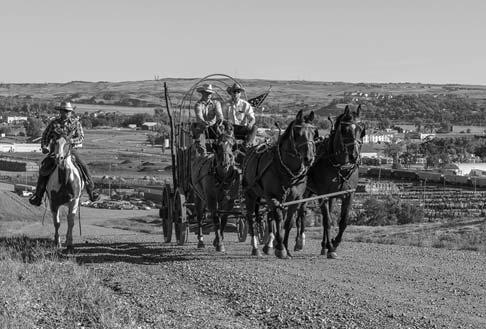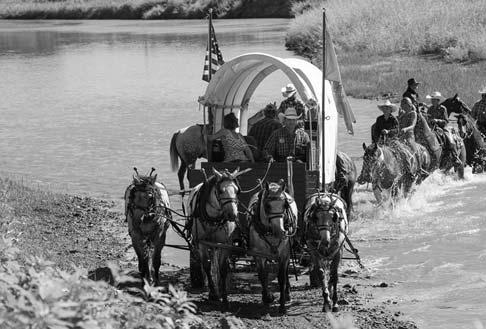
3 minute read
On the Trail, Time Slows Down and History Comes Alive
By Brenda Kleinjan, South Dakota Rural Electric Association
For a few days each summer, participants in area wagon trains slow it down a notch as they roll across the prairie, often times retracing portions of the state’s history.
Advertisement
Large wagon trains have been organized for the past several years, one in 2014 commemorated South Dakota’s 125th year of statehood, tracing a route from the former Territorial Capitol of Yankton, SD, to the State Capitol in Pierre, SD, during a 17-day ride.
Others have wound through the state connecting communities via horse- and oxen-drawn conveyances.
“It’s our heritage; if we don’t pass it on down, it will get lost,” said Willie Cowan of Pierre who has participated in several wagon trains and is an organizer of the one-day event for the Dakota Western Heritage Festival September 16 in Fort Pierre.
When Cowan and his wife, Loretta, started participating in wagon trains about 10 years ago, it took him a bit to recall all the steps involved in relying on horsepower.
“The skills I had learned as a boy took a while to remember,” said Cowan.
But those skills came back as did the realization that when on the ride, one is focused on the task at hand – caring for the horses, looking for obstacles and moving toward one’s destination at a speed that allows one to really observe and enjoy the surroundings. For the Cowans, who are no strangers to rodeo and western life (Willie himself was a state high school saddle bronc champion in the mid-1950s), the wagon trains are a family affair. Their children and grandchildren also participate, either with one of the family’s various wagons or as outriders with the train.
“The most enjoyable part is the kids and observing what they get out of the experience,” said Willie.
As one rolls along the prairie behind the team of horses, Cowan says one ponders things.
“The first thing you wonder is how they got across the prairies with water. They had to follow creeks and rivers,” noted Cowan.
“It gives you a greater appreciation for what those people went through,” said Loretta.
Willie says he has nothing to prove with his wagons and favors modern improvements over authenticity on his wagons.
“The ride on our big wagon is like a Cadillac, not bone jarring,” said Willie. Nylon ropes rather than leather are less likely to break and cause problems, rubber tires smooth out the ride compared to the jarring of wooden wheels.
For the Cowans’ daughter, Colleen McCurrin, the entire process of the wagon train builds a better understanding of western history.


“It’s part of the heritage; it’s how we got here. The people who settled the area arrived in wagons of many shapes and doctor buggies – everyone hitched up a team to do their jobs,” said McCurrin.
The variety of wagons that show up for a wagon train ride bring that heritage to life, and help participants envision days gone by.
For Loretta, the wagon trains helped realize a life-long dream.
“It was always a dream of mine to stand in the wagon ruts of the freight trains that ran from Fort Pierre to Deadwood,” said Loretta. In the Fort Pierre to Deadwood ride a few years back, she achieved that dream.
Her daughter is quick to expand on the comment.
“It’s a tangible thing – you can touch the history,” said Colleen.
And one connects.
“It takes a bit to getting away from needing to get from point A to point B in three hours; on the rides, you might have 10 days,” said McCurrin. “You have to gear down and change mentality.”

The Cowans note that another feature of wagon trains is the camaraderie amongst the participants.
“Everyone helps everybody. If your outfit breaks down, they’re all there to help,” said Willie.
In 2015, the Dakota Western Heritage Festival took participants through a buffalo farm near Fort Pierre and over to the Scotty Phillips Cemetery, named for the Scottish-born rancher and state politician who is credited as “the man who saved the buffalo.”
The 2016 train will take a different trek exploring history to the southwest of town.
The public is welcomed to attend the Dakota Western Heritage Festival. There are limited opportunities for individuals to ride with a wagon.
Reprinted with permission from the South Dakota Rural Electric Association.











